Resistor Color Code Calculator
AIChipLink’s Resistor Color Code Calculator is an interactive tool for identifying resistor values based on 4-band, 5-band, and 6-band color codes. Simply select the colors, and the calculator will display the resistance in Ohms (Ω), tolerance, and power rating. Whether you are building a circuit, repairing electronics, or sorting resistors in your lab, this calculator provides an accurate and efficient way to decode resistor values.

Number of Bands
Resistor Parameters
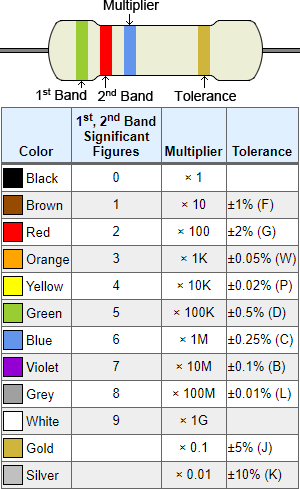
Introduction
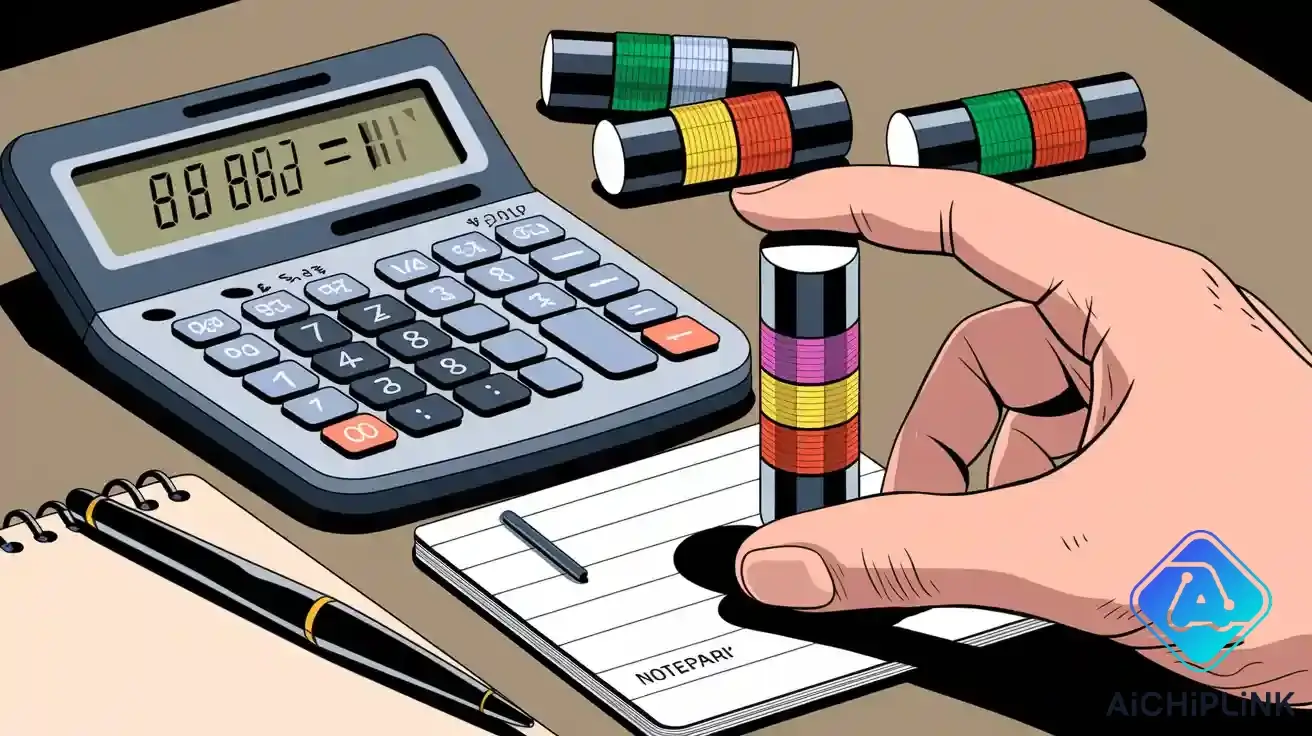
Imagine you’re building a circuit and need to pick the right resistor. You grab a resistor color code calculator. This tool helps you decode those tricky bands fast. Check out the chart below to see the most common resistor values you’ll spot in hobby projects.
| EIA Series | Common Resistor Values | Tolerance |
|---|---|---|
| E6 | 10, 15, 22, 33, 47, 68 | 20% |
| E12 | 10, 12, 15, 18, 22, 27, 33, 39, 47, 56, 68, 82 | 10% |
| E24 | 10, 11, 12, 13, 15, 16, 18, 20, 22, 24, 27, 30, 33, 36, 39, 43, 47, 51, 56, 62, 68, 75, 82, 91 | 5% |
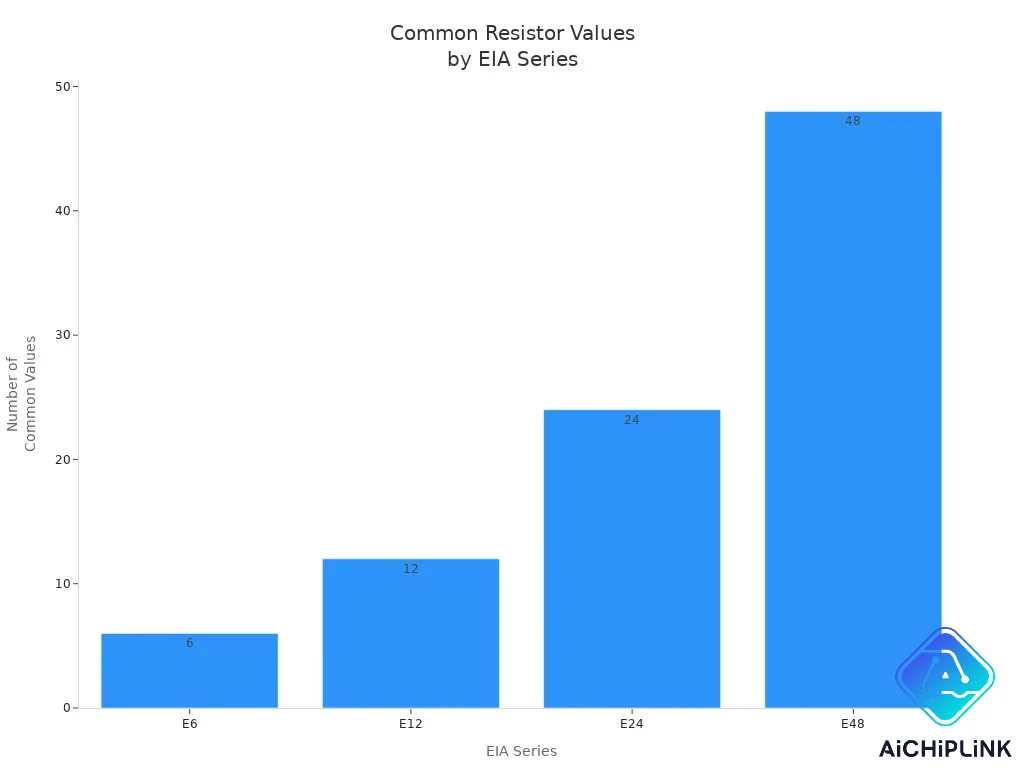
Key Takeaways
- Use a resistor color code calculator to find values fast. This helps you make fewer mistakes in your projects. - Always check the order of the color bands. Start reading from the end where the bands are close together. This helps you read the resistor value right. - Learn about common resistor values and tolerances. This helps you pick the best ones for your electronic circuits.
Resistor Color Code Basics
Band System Overview
When you look at a resistor, you will see colored bands. Each band gives you important information. The number of bands shows how exact the resistor is. You can find resistors with three, four, five, or six bands in your projects. Here is a quick guide to what each band system means:
| Band Count | Significant Digits | Multiplier | Tolerance | Additional Information |
|---|---|---|---|---|
| 3 Band | 2 | 1 | ±20% | Basic resistor type |
| 4 Band | 2 | 1 | ±5% | Most commonly used |
| 5 Band | 3 | 1 | ±1% | Higher precision |
| 6 Band | 3 | 1 | ±2% | Includes temperature coefficient |
Most circuits use four band resistors. If you need more accuracy, use five band resistors. Six band resistors are for sensitive electronics because they show temperature changes.
IEC Standardization
You want to trust the resistor color code every time you choose a part. The IEC 60062 standard keeps the color code the same everywhere. This standard gives you a clear system, so you do not get mixed up. The British Standard BS 1852 also uses the four band resistor system. Manufacturers use IEC 60062 and IEC 60063 to make sure resistor color code tables match.
| Standard | Description |
|---|---|
| IEC 60062 | Governs the resistor color codes and their application in manufacturing. |
| IEC 60063 | Defines preferred values for resistors, aiding in standardization across manufacturers. |
Mnemonic Devices
It can be hard to remember the color order. You can use fun sayings to help you remember the resistor color code. Here are some popular phrases:
-
Big Boys Race Our Young Girls But Violet Generally Wins
-
Beach Bums Rarely Offer You Gatorade But Very Good Water
-
BB ROY of Great Britain had a Very Good Wife
-
Better Be Right Or Your Great Big Venture Goes West
-
Better Buy Resistors Or Your Grid Bias Voltages Go West
You might hear “BB ROY of Great Britain had a Very Good Wife” in class or from friends. These sayings help you read a resistor color code table and pick the right resistor for your project.
Decoding Resistor Color Bands
It might seem hard to read resistor color bands at first. But with practice, you will learn how. You need to know what each color means. You also need to read the bands in the right order. Let’s look at the steps so you can read resistor markings easily.
Reading Significant Digits
When you look at a resistor, you see colored bands. The first bands show the important digits. These digits make up the base value. Here is how you read them:
-
Find the first band. It shows the first digit.
-
Look at the second band. It gives the second digit.
-
If your resistor has five or six bands, the third band is a digit too.
You can use this table to see how digits are shown for each type:
| Resistor Type | Band Count | Significant Digits Representation | Multiplier Representation | Tolerance Representation |
|---|---|---|---|---|
| Four-Band Resistor | 4 | 1st band: 1st significant digit, 2nd band: 2nd significant digit | 3rd band | 4th band: tolerance (precision) |
| Five-Band Resistor | 5 | 1st band: 1st significant digit, 2nd band: 2nd significant digit, 3rd band: 3rd significant digit | 4th band | 5th band: tolerance range |
| Six-Band Resistor | 6 | 1st band: 1st significant digit, 2nd band: 2nd significant digit, 3rd band: 3rd significant digit | 4th band | 5th band: temperature coefficient |
Tip: Always start reading from the end with the color bands. The first band is close to the edge.
Multiplier and Tolerance Bands
After you find the digits, check the multiplier and tolerance bands. The multiplier band tells you how many zeros to add. For example, if the multiplier band is red, you multiply by 100.
-
The multiplier band comes after the digits.
-
The tolerance band is usually the last band.
Here is a quick list to help you remember:
-
The multiplier band shows how many times to multiply the base value.
-
The tolerance band tells you how much the resistance can change.
You can use this table to see tolerance values for each color:
| Color | Tolerance |
|---|---|
| Brown | ±1% |
| Red | ±2% |
| Gold | ±5% |
| Silver | ±10% |
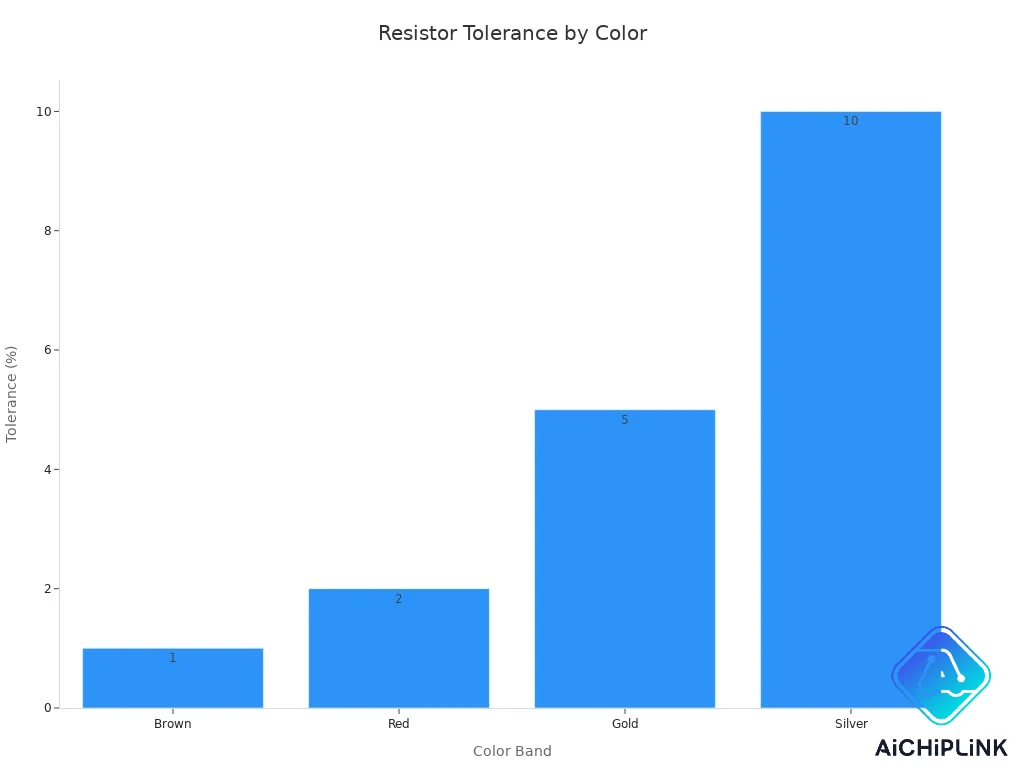
Note: If your resistor does not have a tolerance band, the default is 20%. This means the resistance could be 20% higher or lower than what you calculate.
Gold and Silver Bands
Gold and silver bands are special. They show the tolerance of the resistor. Gold means the resistor can change by ±5%. Silver means it can change by ±10%. These bands help you pick the right resistor for careful circuits.
| Color | Tolerance |
|---|---|
| Gold | ±5% |
| Silver | ±10% |
-
Gold band means ±5% tolerance.
-
Silver band means ±10% tolerance.
If you need a resistor for a careful project, pick a lower tolerance. Gold is better than silver for accuracy.
Step-by-Step Guide for Decoding the Color Bands
Let’s go through the steps to read the color bands:
-
Look at the first two bands. These give you the digits.
-
Find the third band. This is your multiplier.
-
Multiply the digits by the multiplier to get the resistance.
-
Check the fourth band. This shows the tolerance.
Quick tip: Use a color code chart or an online calculator. These tools make reading resistor color bands much faster and easier.
Practical Tips for Accurate Reading
You might make some mistakes when reading resistor color bands. Here is a table to help you avoid them:
| Common Error | Description | Solution |
|---|---|---|
| Misreading Colors | Mixing up colors in bad light can give wrong values. | Use good lighting, magnifying tools, and double-check colors. |
| Incorrect Band Sequence | Reading bands in the wrong order can give wrong results. | Remember the order: first band (most important), second, third (multiplier), fourth (tolerance). |
| Ignoring Tolerance and Temperature | Forgetting these bands can cause problems in circuits. | Always check tolerance and temperature bands for good circuit performance. |
This chart is the fastest way to read a resistor’s value. Just match the colors and read the value. After some practice, you will read resistors quickly. This chart needs no memorizing and no math. Just look at the colors and get the answer.
If you want to make reading resistor markings even easier, try a color code decoder plugin. You can pick the color bands on a virtual resistor. The tool will show you the resistance, tolerance, and temperature coefficient. This makes reading color bands simple for beginners and fast for experts.
Resistor Color Code Chart
Standard Chart Reference
You might wonder how to quickly figure out a resistor’s value. The resistor color code chart makes this easy. You can use the chart below to match each color band to its number, multiplier, and tolerance. This chart helps you avoid mistakes and saves you time.
| Color | 1st Digit | 2nd Digit | Multiplier | Tolerance |
|---|---|---|---|---|
| Black | 0 | 0 | 1 | 1% |
| Brown | 1 | 1 | 10 | 2% |
| Red | 2 | 2 | 100 | 3% |
| Orange | 3 | 3 | 1000 | 4% |
| Yellow | 4 | 4 | 10000 | N/A |
| Green | 5 | 5 | 100000 | 0.5% |
| Blue | 6 | 6 | 1000000 | 0.25% |
| Violet | 7 | 7 | 10000000 | 0.10% |
| Gray | 8 | 8 | 100000000 | 0.05% |
| White | 9 | 9 | 1000000000 | N/A |
| Gold | N/A | N/A | 0.1 | 5% |
| Silver | N/A | N/A | 0.01 | 10% |
| No Color | N/A | N/A | N/A | 20% |
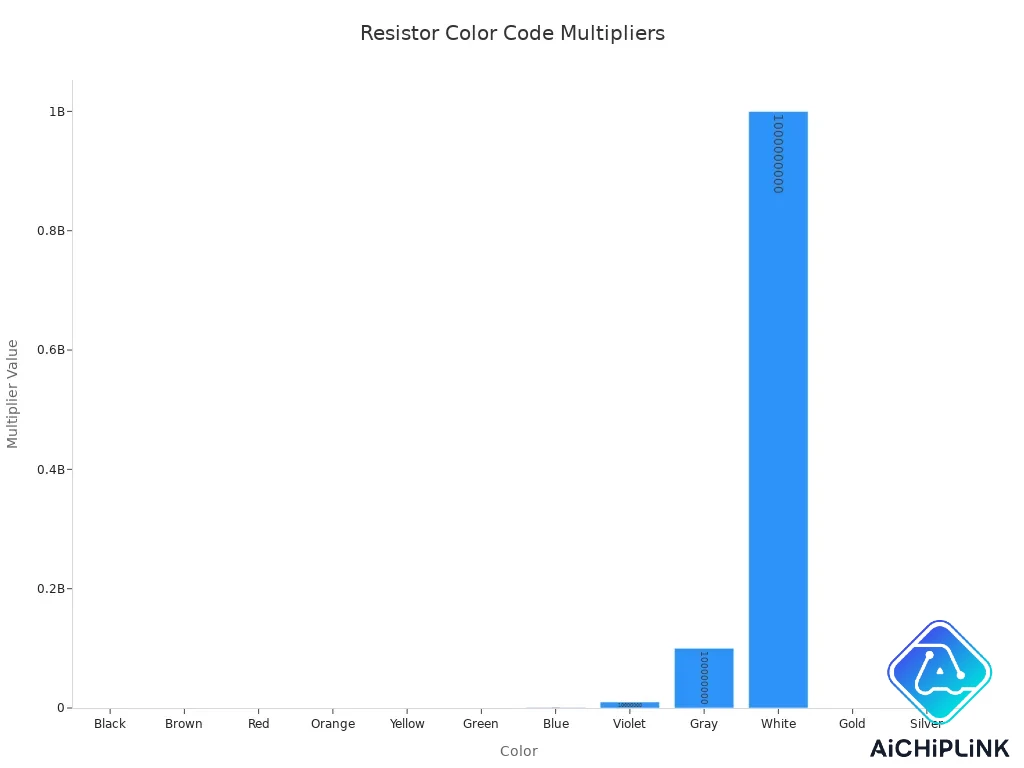
Tip: You can print this chart or keep it on your phone for quick reference during projects.
Using the Chart with a Calculator
You can use the resistor color code chart with an online calculator to get fast and accurate results. Here’s how you do it:
-
First, look at the colored bands on your resistor. Start from the end with the bands closest together.
-
Next, use the chart to match each color to its digit, multiplier, or tolerance.
-
Enter the colors into the calculator. The calculator will show you the resistor’s value and tolerance right away.
-
For example, if you see Violet, Green, Yellow, and Gold, you get 75 x 10,000 = 750,000 ohms with ±5% tolerance.
Online calculators help you avoid mistakes. You get instant answers and better precision. You don’t need to worry about mixing up colors or doing math in your head. This makes your work faster and your circuits more reliable.
Using a calculator with the chart reduces errors and gives you confidence in your resistor choices.
Resistor Value Application
Example Calculation
Suppose you want to light up six LEDs in a row. You need the right resistor so the LEDs do not get too much power. Here is how you find the value with a color code calculator:
| Description | Value |
|---|---|
| Supply Voltage (VSupply) | 18V |
| Forward Voltage per LED (VF) | 2V |
| Number of LEDs | 6 |
| Forward Current (IF) | 20mA |
| Total Forward Voltage | 12V (2V × 6) |
| Resistor Value Calculation | 300Ω |
| Resistor Power Rating | 240mW (0.24W) |
First, subtract the total forward voltage from the supply voltage. Then, divide that number by the forward current. This gives you the resistor value you need. You should also check the power rating. Make sure the resistor can handle the heat.
Tip: Always check your math before picking a resistor. A calculator helps you find resistor values fast and easily.
Ordering Resistors
When you buy resistors, you want the right value and tolerance. Companies sell resistors in different series and tolerances. Here is a table to help you:
| E-Series | Tolerance |
|---|---|
| E6 | ±20% |
| E12 | ±10% |
| E24 | ±5% (also available with 1%) |
| E48 | ±2% |
| E96 | ±1% |
| E192 | ±0.5% (also used for 0.25% and 0.1%) |
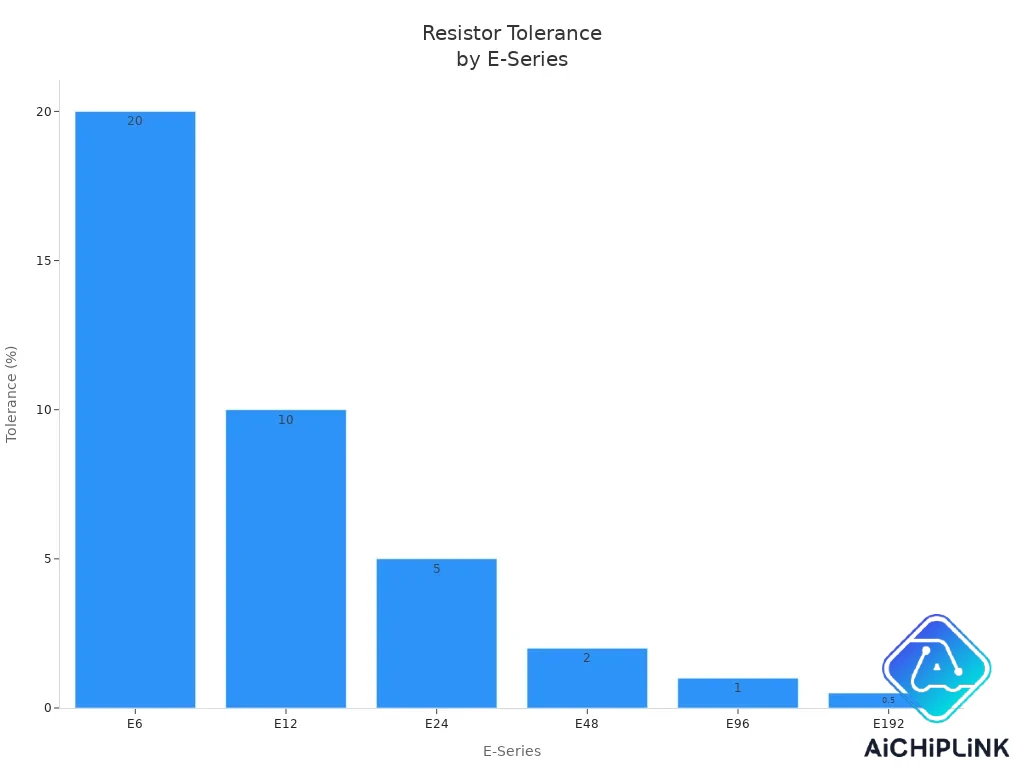
Think about safety and reliability when you pick resistors. Here are some things to keep in mind:
-
Power dissipation is important for your PCB.
-
High-wattage resistors need space and cooling.
-
Stop overheating to protect your parts.
-
Choose a wattage with a safety margin.
-
Look at the environment before picking a resistor.
If you follow these tips, your circuits will work better and be safer. The right resistor value helps your project work well.
You can use a resistor color code calculator to help with electronics. This tool lets you find resistor values quickly. It also helps you make fewer mistakes.
| Benefit | Description |
|---|---|
| Faster and easier identification | Helps you find resistor values fast and easy. |
| Reduces memorization | You do not have to remember all the color codes. |
| Minimizes errors | Makes it easier to avoid mistakes in your circuits. |
-
You finish your projects faster.
-
You get answers that are quick and right.
-
You feel sure of yourself when you are just starting.
Frequently Asked Questions
How do you know which end of the resistor to start reading?
You start at the end with bands closest together. The first band sits near the edge. This helps you read the value correctly. Tip: If you see a gold or silver band, that band goes last.
Can you use a color code calculator for all resistor types?
You can use a color code calculator for most through-hole resistors with color bands. Surface-mount resistors use numbers, not colors.
What should you do if the colors look faded or hard to see?
Try using a magnifying glass or bright light. You can also check with a multimeter to confirm the resistor value.
How do you know which end of the resistor to start reading?
You start at the end with bands closest together. The first band sits near the edge. This helps you read the value correctly. Tip: If you see a gold or silver band, that band goes last.
Can you use a color code calculator for all resistor types?
You can use a color code calculator for most through-hole resistors with color bands. Surface-mount resistors use numbers, not colors.
Hot SKU
AIChipLink – Your Trusted Electronic Components Distributor
12.28 M
Listed Part Number3,000+
Leading Manufacturers4.9 M
In-stock SKU15,000+
Warehouse Area(㎡)










